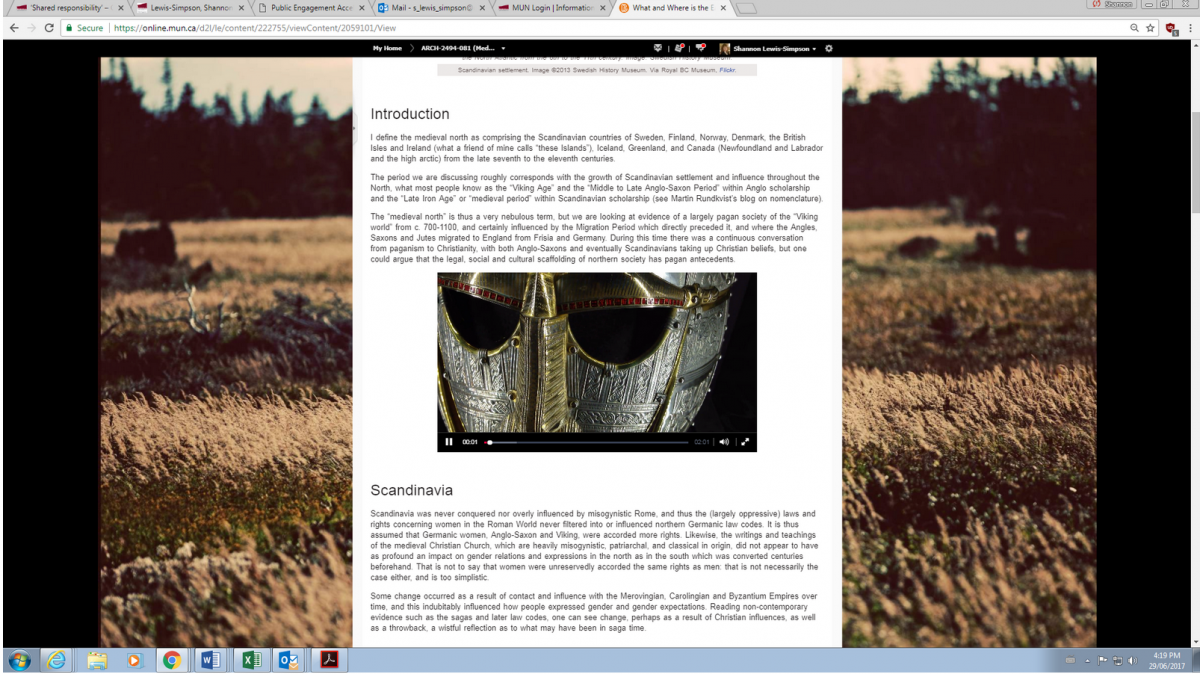Opportunity
Shannon Lewis-Simpson teaches Archeology 2494 ‘Game of Genders: Sex and Society in the Medieval North’ at Memorial University of Newfoundland. The course introduces students to considerations and expressions of gender in northern medieval society, with particular reference to Anglo-Saxon and Viking-Age cultures. The course explores the concept of gender and considers varied gendered identities found in material and textual evidence.
The 13-week, three-credit course was specially designed as a new online course to meet the need for more second year level courses in archaeology. The course was delivered online for several reasons:
- There are many online resources for the medieval period, such as recordings of primary sources, articles, books, law codes and online databases;
- The topics covered, such as consent and factors contributing to identity, are often currently topical and add relevance and interest to a discussion of gender in the early medieval period;
- A visit during the early summer of 2015 to England for an academic conference also offered the opportunity for the instructor to visit key archeological sites and museums in England, gathering material; and
- The availability of convenient, low cost technology such as a mobile phone to make video recordings and collect audio material, while travelling.
Innovation
The online version of the course was designed from scratch with 14 introductory videos (one for each week plus a general introductory video) and 10-11 audio only clips.
The audio and video ranged from recording medieval artifacts, such as a reconstructed Anglo-Saxon helmet of Sutton Hoo, to video from interpretive panels at the Swedish National Museum’s “Vikings” exhibit, to a reading of Beowulf in Old English, and included previously recorded material as well as the original material collected by Shannon Lewis-Simpson.
The course also included a videoed interview with a transgender person, allowing for different voices about gender in the course.
Memorial University’s Centre for Innovation in Teaching and Learning assisted with the production of the audio-visual materials and managed the design of the course.
Any audio-visual material collected from secondary sources was cleared for copyright. The audio-visual material was loaded to Memorial University’s password-protected video server, and accessed through/embedded in D2L’s Brightspace, the university’s learning management system.
Figure 1 below shows how the video was embedded within the teaching materials in Brightspace. Students just had to click on the video insert for it to play.

There were also opportunities for online discussion of course material through the learning management system’s discussion forum. The discussions were moderated by a teaching assistant as well as the instructor.
Benefits and Outcomes
Students were able to access archeological sources and content online and could see and hear representations of original sources through audio and video recordings.
Students for the course came from all programs, from archaeology, gender studies and literature, biology, psychology, and engineering and the course required no prerequisites, so it was essential to ensure all students had adequate access to the same source materials, and all students were evaluated fairly.
Students found the course topical and highly relevant to current debates around gender and appreciated access to the source materials in the course. The course attracted a diversity of students in terms of gender experience. There was a high level of engagement from most students, especially from self-identified transgender students.
Challenges and Enhancements
At the time the course was designed, there was no suitable textbook so a great deal of the content was collected or provided by the instructor. Students reported there was too much material and reading for a second year level course. The amount of reading is under review with the aim of reducing it to more manageable levels.
The discussions during the first half of the course were not graded, but were meant to create a supportive atmosphere so all students would feel comfortable discussing material that would be difficult for some students. The instructor was disappointed at the relatively low participation in online discussions, both assessed and unassessed. During design review, it was decided to minimize the number of discussions, and assign a grade to all to encourage participation, and to keep the group number high to encourage robust discussion.
Potential
Archeology and gender are not the only topics that lend themselves to the use of audio and video. Low cost and convenient technology, such as mobile phones and GoPro cameras, allow for ‘on-the-spot’ collection of high quality audio-visual material, especially when faculty are travelling.
This case also illustrates that the use of low cost media needs to be embedded within a coherent course design, and the support of media professionals and instructional designers helps ensure quality in both the design and the production of online learning materials.
As this case demonstrates, conference travel can also provide an opportunity for faculty to capture the most up to date research for use within their teaching materials.
Further Information
Shannon Lewis-Simpson
Department of Archeology
Memorial University of Newfoundland
St. John's, Newfoundland, Canada


